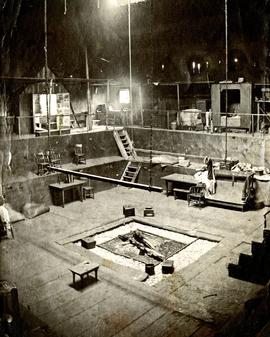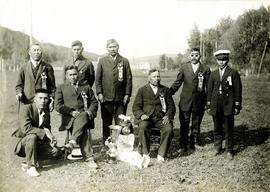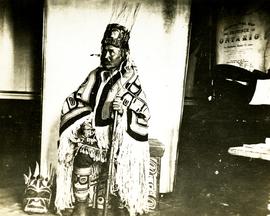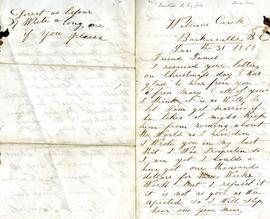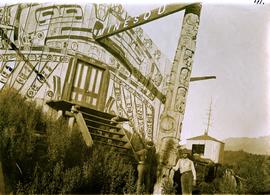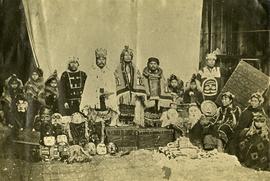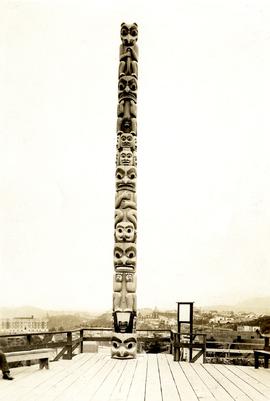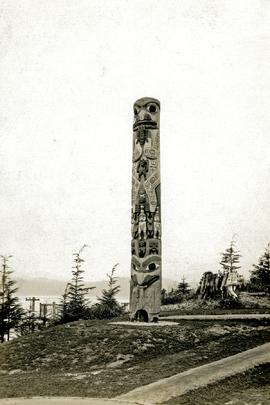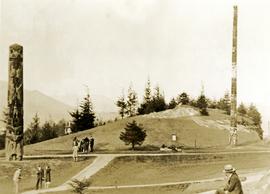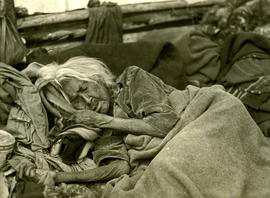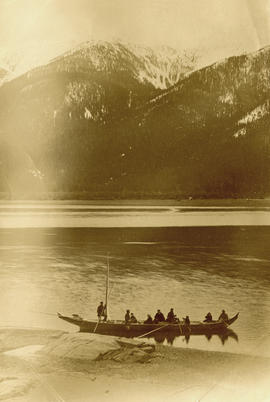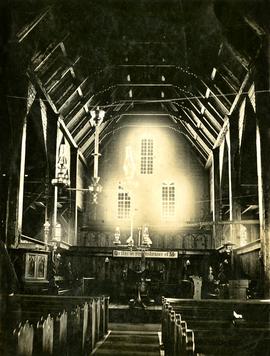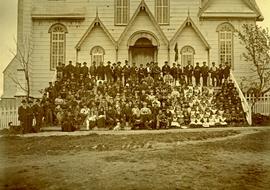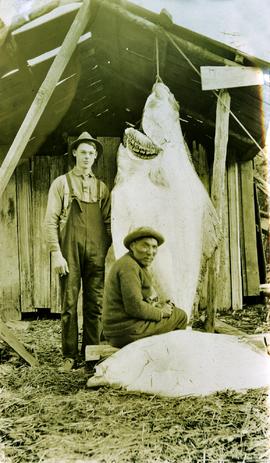Series consists of treaty process advisory records, many of which came out of Dr. Robin Fisher's involvement in the Northern Interior Regional Advisory Committee. Dr. Fisher was often asked to act as a resource person, moderator, or advisor on First Nations treaty-related matters due to his knowledge of the history of First Nation-European relations.
File consists of:
- Indian and Northern Affairs Canada. "Building a New Relationship with First Nations in British Columbia: Canada's Response to the Report of the B.C. Claims Task Force", 1991.
- BC Ministry of Aboriginal Affairs. "In Fairness to All: Moving Towards Treaty Settlements in British Columbia", 1991.
- Ministry of Indian Affairs and Northern Development. "Aboriginal Self-Government Federal Policy Guide", 1995.
- Proceedings documenting a presentation by Dr. Robin Fisher to the Select Standing Committee on Aboriginal Affairs at the BC Legislative Assembly on Monday Oct. 28, 1996 in Smithers, BC
- Map prepared for the Ministry of Aboriginal Affairs showing the territory boundaries via a "Statement of Intent for the Lheit-lit'en Nation", 1996.
- BC Ministry of Aboriginal Affairs. "Glossary of Treaty-Related Terms", 1997.
- First Nations Education Steering Committee, B.C. Teacher's Federation. "Understanding the B.C. Treaty Process: An Opportunity for Dialogue", 1997.
- BC Treaty Commission Annual Report, 1995-1996
- BC Treaty Commission Annual Report, 1997
- Federal Treaty Negotiation Office. "The Treaty Negotiation Process", 1997.
- A commemorative issue of "Hak'ak'a'a" newsletter (August 4, 1998) published by the Nisga'a Tribal Council
- Issues of the Canadian Federal Treaty Negotiation Office publication "Treaty News", including issues from April 1995, July 1996, December 1996, July 1997, December 1997, March 1998, June 1998, October 1999, June 1999, March 2000, June 2000, Winter 2001
Dr. Robin Fisher was a member of the Northern Interior Regional Advisory Committee for treaty process in British Columbia. File consists of meeting minutes, correspondence, documents for discussion, agendas, and notes.
Dr. Robin Fisher was a member of the Northern Interior Regional Advisory Committee for treaty process in British Columbia. File consists of meeting minutes, correspondence, documents for discussion, agendas, and notes.
Dr. Robin Fisher was a member of the Northern Interior Regional Advisory Committee for treaty process in British Columbia. File consists of meeting minutes, correspondence, documents for discussion, agendas, and notes.
Dr. Robin Fisher was a member of the Northern Interior Regional Advisory Committee for treaty process in British Columbia. File consists of meeting minutes, correspondence, documents for discussion, agendas, and notes.
Dr. Robin Fisher was a member of the Northern Interior Regional Advisory Committee for treaty process in British Columbia. File consists of meeting minutes, correspondence, documents for discussion, agendas, and notes.
Dr. Robin Fisher was a member of the Northern Interior Regional Advisory Committee for treaty process in British Columbia. File consists of meeting minutes, correspondence, documents for discussion, agendas, and notes.
Dr. Robin Fisher was a member of the Northern Interior Regional Advisory Committee for treaty process in British Columbia. File consists of meeting minutes, correspondence, documents for discussion, agendas, and notes. Includes: Provincial response to Ts'kw'aylaxw First Nations Position Paper Yekooche First Nation Governance: A Discussion Paper Cheslatta Treaty Discussions Community Profile: Carrier Nation Traditional Territory Carrier songs adapted to Lheidli T'enneh dialect
Dr. Robin Fisher was a member of the Northern Interior Regional Advisory Committee for treaty process in British Columbia. File consists of meeting minutes, correspondence, agendas, and notes for the 1998 Prince George Area-Wide Workshop on Governance.
Dr. Robin Fisher was a member of the Northern Interior Regional Advisory Committee for treaty process in British Columbia. File consists of meeting minutes, correspondence, documents for discussion, agendas, and notes.
Dr. Robin Fisher was a member of the Northern Interior Regional Advisory Committee for treaty process in British Columbia. File consists of meeting minutes, correspondence, documents for discussion, agendas, and notes. Includes results from public forums on treaty negotiations and a map of traditional territories of British Columbia First Nations.
Dr. Robin Fisher was a member of the Northern Interior Regional Advisory Committee for treaty process in British Columbia. File consists of meeting minutes, correspondence, documents for discussion, agendas, and notes.
File consists of correspondence and a program for the "Secwepemc Land Claims Forum" in Kamloops. Dr. Robin Fisher was invited as a "resource person" to speak at the forum.
File consists of:
- Photocopy of 1969 M.A. thesis "And Then We Prayed Again: Carrier Women, Colonialism and Mission Schools" by Jo-Anne Fiske, used as background material for Stoney Creek Woman
- Interviews telling Carrier histories [RESTRICTED]
This fonds illustrates Bridget Moran’s careers as a writer, a social worker and a social activist primarily within the Prince George region of British Columbia. This fonds also contains records pertaining to her personal relationships with family and friends and her receipt of various honours and awards.
Types of records reflective of her career as a writer include: published articles and unpublished manuscripts, drafts and front cover mock-ups, correspondence with editors from Arsenal Pulp Press, grant applications, notebooks, background material, writer’s workshop invitations and overviews, photographs, oral history interviews and transcripts, and VHS recordings of classroom talks given by Bridget Moran, Mary John and Justa Monk re: her publications.
Types of records reflective of her career as a social worker and social activist include: annual reports, work journals, correspondence and published newspaper articles re: social policy, photographs, and general background material. Correspondence, photographs and newspaper clippings highlight her personal relationships, while her receipt of honours and awards is demonstrated through copies of letters of recommendation, newspaper clippings, photographs, VHS recordings of award ceremonies, event itineraries, congratulatory correspondence, and invitations.
The Bridget Moran fonds has been divided into the following four series:
- Published and Unpublished Materials
- Career Related Materials
- Personal Papers and Correspondence
- Honours and Awards.
Series consists of newspaper clippings, correspondence, photographs, pamphlets, newsletters, advertisements, contracts, notebooks, audiocassettes of oral interviews and readings, transcripts, book launch announcements, front cover mock-ups, edited drafts, manuscripts, fact sheets, poems, catalogues, bookmarks, skits, conference events programme, poster, grant applications and related correspondence, a wooden placard, handwritten notes, book reviews, inquest reports, background material, VHS recordings of classroom talks given by Bridget Moran, Mary John and Justa Monk re: her publications, and ephemera. This series contains material from all five of her publications:
- (1988) Stoney Creek Woman: The Story of Mary John. Vancouver: Arsenal Pulp Press.
- (1990) Judgment at Stoney Creek. Vancouver: Arsenal Pulp Press
- (1992) A Little Rebellion. Vancouver: Arsenal Pulp Press.
- (1994) Justa: A First Nations Leader. Vancouver: Arsenal Pulp Press.
- (1996) Prince George Remembered. Prince George, British Columbia: Moran Publishing.
This series also consists of, but is not limited to, a number of unpublished manuscripts and drafts and/or writing contest submissions also written by Bridget Moran, such as:- "Mary and Me" (ca. 1998)
- "Where Winds Come Sweet" (ca. 1981)
- "The Horizontal Land" (ca. 1992)
- "The Summer of '81"
- "The Relief Cheque" (ca. 1998)
- "The Case of the Box of Matches" (ca. 1987)
- "Unholy Deadlock" (ca. 1990)
- "The Numbers Game"
- "Reflections on Theme" (ca. 1967)
- "Come Hell or High Water" (ca. 1976)
- "Man Alive"
- "The Deadbeat Mystique"
- "Hell on Wheels"
- "Backstairs at the Palace"
- "James MacCallum" (ca. 1984)
- "Hushaby, Baby" (ca. 1981)
- "The Decline and Fall of Mr. Sullivan"
- "Case History of a Gadfly"
- "Welfare and the Good Life"
- "Childhood Memories" (ca. 1976)
- "The Three Musketeers" (ca. 1974-75)
- "A Child's Christmas in Saskatchewan" (ca. 1979)
- "Diary of Success Homecoming"
- "My Old Flame" (ca. 1992)
- "O Ye Dry Bones" (ca. 1996)
- "Supper, Little Children" (ca. 1983).
Fonds consists of original, silent 16mm reels that portray the natural, social and land use history of the Bella Coola and Chilcotin regions named the "Natural and Guiding History of the Bella Coola and Chilcotin Regions".
Possible locations that Al Elsey filmed include: Bella Coola, Bella Bella, Anahim Lake, Alert Bay, Nimpo Lake, Bulkey Valley, the Rainbow Mountains, Tweedsmuir Provincial Park, Dean River, Bella Coola River, Tchaha Lake, the Chilcotin region, the Ulkatcho Mountains, Lassard Lake, Fenton Lake, Atnarko River, Wells Gray Park, and Holt Homestead.
Fonds consists of the McGregor Model Forest records documenting the operational history of the model forest from 1992 through 2007. These records document the various functions of the McGregor Model Forest reflected in the four series:
- 1) Projects and Research consisting of reports, proposals, and project and research materials ranging from 1994 to 2006
- 2) McGregor Model Forest Association Administration records largely consisting of Board of Directors Meeting Minutes from 1993 - 1997; work plans from 1994 - 1997, 2002 - 2003; annual reports from 1995 - 2006; Technical Steering Committee Meeting Minutes from 1993 - 1997
- 3) Publications by the McGregor Model Forest Association, the Canadian Model Forest Network, Natural Resources Canada, or other forest research organizations
- 4) Promotional Materials including materials from outreach events such as posters, presentation slides, and ephemera.
Handwritten annotation on verso of photograph reads: "W.E. Collison Masset. Interior of Chief [Weah's?] house".
Caption under printed version of photo in W.H. Collison's book 'In the Wake of the War Canoe': "The house is about 40 feet square, forming one large room. The upper cubicles are on a level with the ground, which in front of them is excavated so that the fireplace in the centre is twelve feet below the surface. A ledge, for the use of slaves and dependents, is left half-way down."
Photograph depicts 8 men posing in suits and ties, and a young girl, Ruth Adams, holding trophy seated in foreground. The group is gathered in open field, large building and hills visible in distance. Man on far right stands in uniform.
Handwritten annotation on verso reads: "Gitlakdamix Village Council 1923. [Charlie Morven] Chairman. / Geo. Manase. / John Davis. / Dennis Woods. / Andrew Nass. / James Adams. Secretary. / Frank Blackwing. Chief Constable. / Walter McMillan (Nass). Constable."
Handwritten annotation on verso reads: "For heading of page 15 of Introduction to 'Trophies from a Long Trail.' Nishka Chief in his robes and Head-dress."
Item consists of a letter written by John McCormick to a person named James; it is not made clear if James is a friend or relative. In both his letter to James, John McCormick makes several references to Victoria. His familiarity with Victoria suggests that he may have travelled from Victoria to Barkerville to mine for gold. In his letters to James, John McCormick describes having no money and living under poor conditions. He mentions the great fire that swept through Barkerville and that he lost nothing due to its distance from his house. McCormick also mentions that the Indians are dying quickly of Small Pox in Victoria.
Photograph depicts two men standing at base of totem pole in front of large elaborate lodge building with post reading "MINESQU". Smaller structure stands in background (elevated cache?).
Handwritten annotation on verso reads: "Chapter XXIV. No. 3. A chief's lodge and totem Nass River."
Three men stand in centre, each wearing a chief's dress and head-dress. Family members stand and sit on either side. Carved boxes and masks are positioned in foreground. The group poses in front of drapery hung against tall wooden wall.
Community members have stated that the people in this photo are from the Gitwilluyaxw clan from the wolf tribal house of Ksdiyaawak. The photo was taken at Gitlax̱t’aamiks along the Nass River.
Handwritten annotation on verso reads: "Tsimpshian Chiefs & family. Goods [for or fr.] Potlatch".
Fonds consists of the personal records of Nedra (Ginty) Jane Paul [b. ca.1920-d. 1990]. Personal records include the 1938 Lord Byng High School Annual, 2 teaching certificates, and 1 photograph. Paul worked as a teacher in the Chilcotin and Bella Coola regions of BC and the primary items of the collection are 8 recordings generated by her with members of First Nations Communities at Alkali, Red Stone, Kleena Kleene and Bella Coola from 1964-1971. There are 8 original audio reel to reel recordings (and 2 tapes which are copies of the recordings later created by P.J. Thomas, who accompanied Paul on the interviews). Recordings include stories and songs.
Sem títuloFile consists of the "First Nation Participation in Canada's Model Forest Program 1992-1997: Accomplishments and Opportunities" a report prepared by the Canadian Forest Service, Natural Resources Canada. This report describes the First Nations participation in Canada's Model Forest Program with details on the Western Newfoundland Model Forest, the Fundy Model Forest, the Bas-Saint-Laurent Model Forest, the Eastern Ontario Model Forest, Lake Abitibi Model Forest, Manitoba Model Forest, Prince Albert Model Forest, and the Foothills Model Forest.
File consists of "McGregor Model Forest: First Nation Youth Programs in the Natural Resource Sector of British Columbia" by Brandon W. Prince. Includes case studies of Adams Lake Indian Band (Sexqeltqi'n), Duke Energy: Gas Transmission, the Aboriginal Human Resources Development Strategy, Nicola Valley Institute of Technology - Natural Resources Technology Program, and UBC Summer Forestry Camp for First Nation Youth.
File consists of the report "First Nations Resource Management: An Annotated Bibliography" from the 'Linking Forestry and Community in the Tl'at'en Nation: Lessons for Aboriginal Forestry' project by Christine Callihoo.
File consists "Report to the McGregor Model Forest Association: Development Plan for Theme 4: 'First Nations Sustainable Forestry Management' and a Report on 'Consolidating Traditional Ecological Knowledge Tools within the McGregor Model Forest (PG TSA)" Submitted by Annie L. Booth and Norm Skelton. Report includes: "First Nations, Sustainable Forest Management, and the Prince George Timber Supply Area, An Annotated Biography" including project introduction, conclusions and appendices.
Series consists of published materials by the McGregor Model Forest Association, the Canadian Model Forest Network, Natural Resources Canada, and other forest research organisations. Series consists predominately of printed textual materials but also includes two CD-ROMs containing published works.
Series consists of reports, proposals, and project and research materials ranging from 1994 to 2006. Series includes reports on Sustainable Forest Management, proposals for planned project phases, consultant reports, symposia notes and ephemera, secondary source research for projects and planning, and reports on work with First Nations communities.
Photograph depicts a totem pole standing on what appears to be a large wooden deck or boardwalk, view of the city in background.
Handwritten annotation on verso reads: "Totem pole in park in Prince Rupert".
Photograph depicts a large totem pole next to groomed dirt paths. Power poles and river visible in background.
Handwritten annotation on verso reads: "Edenshaw pole in park at Prince Rupert."
Groups of men and women can be seen gathered on paths between two large totem poles.
Handwritten annotation on verso reads: "Totem Park Pr Rupert park."
Handwritten annotation on verso reads: "A very old Tsimpsion women - said to be over 110 yrs old."
Canoe with mast floats close to shore in foreground, mountains visible across river in background.
Handwritten annotation on verso reads: "Arch. W.H. Collison & wife with native friends en route up Skeena River."
Banner at front of sanctuary reads "Do this in remembrance of Me".
Handwritten annotation on verso reads: "Interior of old church. Built by natives themselves".
Large group of women, men, and children pose on front steps of church. Some men standing in back hold brass instruments. Bishop Ridley (with long beard) sits in front centre between W.H. Collison (on right) and his son W.E. Collison. Photograph depicts the first church built in Metlakatla, which was burned in a fire in 1901, and replaced in 1903.
Handwritten annotation below image reads: "A gathering of Missionaries and Indians in front of Metlakahtla Church During Synod"; on verso: "[Ven?] Arch Collison & Mrs Collison".
Arthur Collison stands behind large fish hung from wood shelter, Noah seated in foreground. Arthur is the youngest son of Marion and Archdeacon W.H. Collison.
Handwritten annotation on verso reads: "Arthur Collison with our friend 'Noah' with catch - at Kincolith Nass River".
Audio recording consists of an interview conducted by Bridget Moran with Mary John.
Audiocassette Summary
00’05” Bridget is interviewing Mary John who discusses a potlatch held at Stoney Creek that Bridget attended. Bridget asks about the talking stick and she asks Mary John to explain its significance. Mary explains there had been a naming ceremony about a year ago and that a woman named Maisie had changed clans from her mother to her father’s clan. Mary notes while this is unusual, her father’s only son had died and therefore requested that the daughter changed clans. At this ‘September potlatch’ therefore this woman had to change tables at the potlatch.
04’00” Mary explains the context of the September Potlatch. She notes that Maisie had hosted this potlatch to pay back for the gifts that had been provided for her from a year ago when she received a new name. They then discuss the amount of money that the host gave to the guests and the amount of money that is normally provided – there is no particular amount ‘whatever you wish’ Mary notes she had provided Maisie with a gift last year of $100 but that Maisie gave her back $200 – that is not required – there is no required amount
07’30” Mary explains that at a potlatch you are expected to bring a case or few bags of food
08’00” Mary discusses the type of food provided at a potlatch; it is traditional food not western food; Bridget notes there was caribou provided there. Mary explains that the host of a potlatch asks people to hunt for moose and deer meat in order to prepare for the food to be served. Bridget then talks about the food that was served and Mary notes it included also fish and beaver.
11’00” Bridget asks Mary to talk about the gifts given to her daughter Flo at the potlatch in exchange for a loan she provided to another woman whose husband had died a year before. Bridget notes it was a ‘touching’ moment.
12’00” Mary talks about the Priest ‘Father Brian’ who was at the potlatch. Four clans collected money and gave it to the priest for his work [missionary work?]
15’07” Mary explains the situation of Geraldine Thomas –that at the potlatch she was not seated before; that is she was not initiated before and so she was seated at the potlatch
15’57” Tape stops momentarily
16’09” Mary continues to talk about Geraldine and the potlatch events; the significance of the tapping of the talking stick; then she was seated and guests give her gifts. Then Mary talks about Ernie and her late daughter Helen who also wanted to cross their clan but that Mary ‘did not let her go’
20’00” Mary talks about the feelings of a child who gives up their clan and that it is like ‘giving up one of your children’ as Celina noted to Bridget at the event.
21’00” Mary talks about her son Ernie who crossed over to his father’s clan and that he was gifted at the potlatch
22’00” Bridget then notes that at this potlatch that the Frog Clan became host of the Grouse clan at this potlatch. Mary explains that the clan then had debts to pay at this potlatch.
26’00” Mary talks about the death of Stoney Creek members; she is unsure when there will be another potlatch in Stoney Creek.
28’00” Bridget notes that she did not understand the ceremony as it was in Carrier language; however Bridget notes it is a pity the white world doesn’t see potlatches as they are ‘so touching’
31’00” Mary explains that each clan takes care of the deceased family members and takes care of putting up the headstone
32’00” Tape ends abruptly
Audio recording consists of an interview conducted by Bridget Moran with Mary John.
Audiocassette Summary
Scope and Content: Tape consists of a recording of Bridget interviewing Mary John primarily about her visit to the former native village site of Cheslatta
Side 1
Interview in process
00’05” Bridget interviews Mary John, Mary is referring to Madeline her niece.
1’00” Bridget asks Mary what made her decide to go to Cheslatta – to see the site where she had lived. Bridget asks if it was a ‘rediscovery’ trip. Bridget asks if this is where the village was burned out and flooded out [by Kemano development] Mary talks about her son Ernie wanting to go there and create a territorial hunting ground. She talks about going there with her niece Madeline and Alex
8’40” Mary explains how they got to Cheslatta; the travel there was by van through Francois Lake and via logging roads; it took about hour and half drive
11’00” Mary explains it was not the village that had been flooded that they went to; not the original village; she notes there was a campsite set up for them but it was cold at night. There were people there from Stellaco, about 75 total. She describes making bannock on a stick over the fire ‘the real bannock’ for the youth – like an “Indian pizza” (she laughs)
16’00” Mary continues to talk about the activities that she did at Cheslatta; show the youth how to fish, spear fish, clean fish, cut in strips and smoke the fish. There was no smokehouse but they created a lean- to and smoked the fish. Mary also notes another day Mary and Madeline took the youth to the bush and talked to them about uses of trees –
22’00”-20’25” Mary describes the steps involved with showing the youth at the Cheslatta camp how to collect spruce in order to build a smoke house for smoking the fish
29’30” Mary discusses food that she prepared for the gathering for the people
31’00” Mary talks about the group visiting the old village Cheslatta after the gathering
Mary then leaves to attend to a crying baby [a great-grand-child?]; they greet the mother
33’00” Bridget refers to a group of kids she talked to at Kamloops about their book Stoney Creek Woman. Bridget tells Mary she has letters written to Mary John by several students who had read Bridget’s book that she wants to show her
36’00” They continue to talk about the former Cheslatta village and what the former village residents want to do about the village; Mary notes there are archaeologists working there. Mary states the people have not yet received compensation for being taken off their land. Bridget notes those people loss their sense of community
38’31” Mary remarks the people at Cheslatta “have a good chief” “very humble person”
39’40” Bridget asks Mary about the Lejac pilgrimage. Mary then talks about the pilgrimage that is held at Lejac and that she had just been there ‘on Sunday night’; she notes it is arranged by Celina; she notes there were Tache people there. Bridget asks if there are children buried at Lejac and Mary notes there are children and students buried there – about 15 to 20 buried there.
43’00” They briefly discuss if this was a rediscovery for the Cheslatta people at the event. Mary agrees; she notes she stayed there for 10 days; Bridget remarks it was similar to Mary’s former camp of what she had experienced at Wedgewood. They talk about Mary’s son Ernie and that he has in Bridget’s view ‘leadership qualities”
45’30” Bridget asks about getting a bannock recipe for a Senior’s cookbook. Mary begins to tell the recipe
Side 2
47’40” Mary continues to show Bridget how to make bannock
50’00” Mary briefly refers to the event at Cheslatta again
End of tape
Audio recording consists of an interview conducted by Bridget Moran with Mary John.
Audiocassette Summary
Context: Tape recording is an interview between Bridget and Mary John in which Bridget initially asks Mary John about events after the inquest into Coreen Thomas’s death. Bridget notes also that she wants to provide an update on Mary John’s life 10 years after the inquest.
Side 1
00’05” Bridget asks Mary John about her role in the Coreen Thomas inquest. Mary thinks that she discovered Coreen’s death due to the ringing of the church bells [to announce a death]. She tries to recall the series of events leading up to her time being involved in getting an inquest. Recalls Sophie Thomas’ desire to have an inquest into her death
6’00” -10’00” She recalls that the [Indian] Homemakers Association became involved in attempting to get an inquest. She says ‘she was just tagging along with it …I was not a fighter” Bridget notes that Harry Rankin stayed at Helen’s house when he represented the Homemakers Association at the inquest. Bridget recalls the ‘marvellous’ dinner that was put on for them at the time of the inquest by Mary John and Helen. Mary John notes it was at the invitation of the Homemakers Association for the group to come to her house.
10’:00”-14’00” Bridget and Mary talk about follow-up to the inquest and Coreen’s family.
14’50”- 25’00” Mary talks about her involvement as well as others in the creation of the Elders Society after the death of Mary’s son due to drowning in 1978. The Society had workshops in an effort to revive their culture with the hope of having the younger generations take pride in their culture. One of the activities was the building of the Potlatch House in 1980 where they did traditional activities including tanning of hides.Talks about acquiring the land to build the potlatch house and having the Chief take care of getting the land from BCR; the Society cleared the land twice over to set up the house. Mary explains that the Society acquired funding of $93,000.00 from ARDA [?] to clear the land from the logs and build the house.
26’00”-30’00” Mary talks about a new project that the Society has to build 10 rental tourist cabins as a business for the youth to operate. Bridget suggests it could be similar to that at K’san. Mary also explains that there is a cook-house at the Potlatch House as well and that it has been used for community events, weddings, dinners, organizational events also.
Tape stops momentarily and starts again
30’05”- 36’00” Mary talks about the drowning of her son and finding of his body in 1978 as well as other tragedies that happened in the community which led to the creation of the Elders Society to assist the youth
36’30” -39’30” Mary talks about the joys of finally having her own house and the building of the house
39’32” -42’40” Mary talks about the organizations that she is involved in now. She talks about a film made in the community about social workers coming in the community to work with Elders to care for issues related to youth. She notes that ‘that’s when the ice broke’ and it made a difference.
43’00” She talks about a dinner that she holds every year for the police officers to thank them for the service they do for society
43’30” Talks about fishing at Fraser Lake
44’00” -46’00” Mary talks about her work now at her house to teach the youth about their culture: making of baskets, moccasins, tanning of hides
End of side 1
Side 2
46’30”-48’00” Mary continues to talk about the activities that she does with native youth to educate them about their culture
48’50” Bridget asks about whether the youth are involved in tree-planting and asks another woman in the room (Bernice?)
50’00” – 56’00” Bridget asks what her three wishes are for her people: better lives; more education for the young people to have better jobs; they need to get out to the white world and not be so isolated; she refers to when she worked in ‘the white world’ She talks about the isolation of the reserve and yet the protection that it offers to the people as well. Bridget and Mary talk about the reserve offering a way to protect the native culture. Bridget asks why it is important to protect their culture. Mary notes their culture is so important; she notes that other cultures like Japan and China haven’t lost their culture so why should the natives.
56’05” Mary notes that none of the grandchildren speak Carrier and the need to protect their culture and language when being surrounded by a white community. Refers to her grandson Fabian who is in the room
57’00” Bridget recalls a Fort St. James woman who tried to keep native kids out of white schools. She wanted them to be kept on the reserve so that they didn’t lose their culture. She talks about the fight by many to get their native status back – those whose one parent is not native
58’00” Mary talks about her worries for the young native people in the community who fear they have no future and who have no employment or education.
End of tape
Audio recording consists of an interview conducted by Bridget Moran with Mary John.
Audiocassette Summary
Context: Recording is the continuation of earlier sessions by Bridget and Mary John talking about her life – appears to continue on from the other tape sessions numbered to #8 [Accession # 2008.3.1.211.4]
Side 1: “Mary John #9”
0’05” Bridget interviews Mary John and asks about Mary John’s grandmother who lived at the reserve at Fort George. Mary notes that her grandmother was sent back to Fort George and then to Stoney Creek after husband died. Her Grandmother remarried; she died in the 1950s. Mary talks about her grandmother’s marriage with Za (Jean) Paul – that was not an arranged marriage; her Grandmother “she had a hard life”
4’00” – 7’30” Mary Johns’ mother married Johnny Paul – not arranged; Mary notes that she was born in Fort George. Mary lived with her Grandmother Ann on reserve in Fort George. Mary then talks about her sister Bella – who married Mike Ketlo (sp?) and their children. She died of tuberculosis in the 1950s.
7’40” Bridget asks about the Mission School in Fort St. James – near the church “that is on Mission land” Which is where the village originally started. They talk about the church’s history briefly.
9’00”-14’00” Bridget asks Mary about her schooling at Lejac – Mary says they had reading, writing, arithmetic, penmanship and history. There was no science taught. Mary then describes the routine at Lejac. Doing chores and then breakfast at about 7:30 and then did cleaning chores in the dormitories. Then they attended their classes; then lunch, then played outside and then came back for sewing or embroidery, knitting and then back in classes until 4:00pm. Mary describes recreation – swimming, playing in the field, chores – pulling roots/stumps etc. Bridget talks about Joanne (Fiske?) thesis on the distinction between native boys and native girls’ activities and education at the residential school and that it enabled them to go to work in the hospitals and offices but that the farming education that was taught to the boys didn’t help them as there was no agriculture on the reserves. Mary notes she was ‘teachers pet’ as she had music lessons for singing. Mary notes she didn’t do anything in the kitchen but took mail to the post office and looking after the office for the Mother Superior. She feels she learned ‘the basics’ [but] then they ‘kicked you out at 16’
15’00” Bridget asks about the differences in disciplining methods of children – she notes that it is not part of Indian culture to spank children. She notes it is part of her husband’s sisters to discipline her children – not her or her husband’s duty
17’00” Mary talks about the residents at Stoney Creek who objected to school at Lejac because of harsh disciplinary methods used with their children
18’00” Mary talks briefly about the food at Lejac and speaks briefly to another unidentified woman [Sabrina?] in the room about food preparation [canning?]
19’50” Bridget asks about the Stoney Creek residents who wanted to have a school at the village in the 1950s and wanted their children to go to school there.
20’00” Mary speaks briefly about Father Coccola and that he did the negotiation about the move of the people from the reserve at Fort George to Shelley and about some compensation acquired by the residents. Bridget notes he ‘did not do a favour to the Indians’ – Mary notes that they were forced to leave ‘very illegal’
22’00” Mary speaks again about Father Coccola who could be ‘a very strict man’ but who took care of the people when they were sick and dying
23’00” Mary talks about another priest (unidentified) that she really liked who gave her a job c.1935 when she and her husband cleared land for Lejac and the priest treated them really well. She thinks he was from the Yukon as he had gold nuggets
25’00” Mary talks about her children going to Lejac in the 1950’s
26’00” Bridget talks about a social worker who came to Stoney Creek in c.1955 and Bridget was asked to come out by the Indian Agent to investigate what was the issue. This social worker was scared of being on the reserve; Mary thinks this woman had marital problems and drank a lot
28’00” Mary talks about the Day school operating c.1951 for a short time and the kids were bussed back and forth; other kids ‘orphans’ went to Lejac (lived there)
Tape is poor after this; noise with squeals and recording is faster
29’00” Mary talks about her children (Helen and the boys) not liking Lejac. She notes that one of the boys didn’t like it ‘but didn’t complain’ about it. She notes that ‘no one would talk about it’ “the whole village would be silent” when they left; and the children would be crying.
30’00”-33’00” Bridget asks Mary to discuss her wedding in more detail – Bridget notes that she already has on tape about the wedding night itself but asks for more information about the wedding day. Mary begins to talk about the wedding; there was a Mass, the guests and there was a band….
Tape is unintelligible after this; recording is broken up with interference and then there is no recording End of side 1
Side 2 “Mary John #10”
This side of the cassette has no recording
Audio recording consists of an interview conducted by Bridget Moran with Mary John.
Audiocassette Summary
Side 1
0’02” Improvements within the Department of Indian Affairs; she notes that Indian Affairs was tricking the band. The Indian Agent took a logging contract away from Mary John’s son Ernie because he refused to pay the rate that they wanted in stumpage fees
4’00” Mary John recalls when the community started to speak up against Department of Indian Affairs about 1942. She recalls the Elders Society and the Indian Homemakers Association. She explains that the Elders Society supports the preservation of the Indian culture and arts/crafts; which involves set up of activities including summer camps; showing youths how to use fishing and hunting tools and recreation tools. Bridget asks about Elders involved in the Society.
13’00” Mary talks about teaching Indian language at the school for the youths and also teaching previously in the village for the children yet none of the children continue to speak their language today. But now with parents speaking at home it’s difficult to have them continue to speak their language
16’00” Bridget asks Mary to recall the time when she was named Citizen of the Year in Vanderhoof in 1978. Mary shows Bridget the award and recalls that they ‘had a big dinner’ for her. Mary notes it was a surprise, Mrs. Campbell brought her there – Mary John recalls that she didn’t have a speech planned
19’00” Bridget asks her to explain about the tanning of hides. Mary explains the process from the time of the shooting of the moose; fleshing and scraping of the hide. She explains how to use the knife on the hide so you can see the tissues of the skin. Then Mary turns over the hide to the hair side and shaves off the hair on the hide and then shows Bridget how it is scraped. They discuss the blade and how it is sharp. She explains it is then washed many times to clean the blood off and then it is stretched. She explains it is then spread with oil/ possibly fish oil – the whole hide is oiled up and then left about a week to dry. Then once dry you use another scraper to ensure it is soft. She notes it is a lot of hard work and time to complete. They then talk about smoking of the hides and Mary shows Bridget hides that she had made herself. Mary explains that the Elders have a class for the youths to show them how to tan hides.
29’00” Bridget asks Mary about the last potlatch held. Mary explains what a potlatch is and when it is viewed as a pay-out. A potlatch is thrown to pay back another clan for a service or a kindness that was done to them. She talks about potlatches for deceased persons; and how clans host potlatches. She talks about the foods prepared at a potlatch. Mary recalls “it can cost thousands of dollars” and notes plans in progress for the next potlatch to be held in August in Stoney Creek.
36’00” Recalls when potlatches were made illegal – recalls gifts she received years before at potlatches and ‘that someone benefits from it’ Years ago hides and dried goods were given out. Potlatches started up again in about 1934 and they held a potlatch for her mother when she died.
40’00” Mary explains there are two clans at Stoney Creek – the Frog and the Grouse; she explains that you don’t marry within your own clan.
45’00” Recalls the death of some of her relatives
End of Side 1
Side 2
45’02” Mary talks about her siblings who are still alive
48’00” Talks about the preparation and setting of nets in canoes for fishing
52’00” notes people like to be called native – not Indian
52’30” Bridget asks Mary what she thinks that has changed that is good? She thinks that the good things are better homes, electricity, cars, education, transportation and better roads. She fears there isn’t as much closeness as there was years ago among families – now people sit at home and watch TV. “People use to do things together – they don’t anymore.” Mary points out that another good thing is that people now get pensions.
56’00 Mary John speaks about her sewing business that she now has and the making of mukluks and moccasins
57’00 Bridget recalls bringing her Mother to Stoney Creek Reserve c.1954 and her mother noting her poor life in Ireland and recalling the poor people she saw on the reserve at that time and telling Bridget she had to help those people
59’00 they both refer to poor services done by the Department of Indian Affairs in the 1950s
End of tape
Audio recording consists of an interview conducted by Bridget Moran with Mary John.
Audiocassette Summary
Scope and Content: Tape recording is an interview between Bridget Moran and Mary John – a continuation of interviews.
Side 1
0’02” Bridget asks Mary when she quit smoking - in 1972
1’00” Mary notes there was no talk of sex life; not part of First Nations culture
2’00” Mary talks about when she started working at the hospital; she was able to save money and her husband drove her back and forth; lived in a tent to save money; they pumped water to drink from a well 1 mile away so that they did not get sick; she notes she began working at hospital after her husband lost his seasonal job
5’00” Mary notes they had to have a tribunal hearing to get old age pension for her husband because his birth was not registered
7’00” Mary recalls that the Depression did not hit reserves as hard as white people because ‘they had always been poor’; yet at that time they were never without food. She talks about tough times during the Depression – could not find work only relief; got used clothing from white people
10’00” Mary refers to a Mrs. Campbell, a white woman who was a widow and had small children who was also poor in the Depression and showed her how to repair socks
12’00” She notes that they did not have much of a relationship with the Indian Agent – they knew he existed but they did not see him much; viewed him as a representative for the Indians; some [of the Indian Agents] were good and some were bad; she describes difficulties with the Indian Agent and getting little food: only a single ration (24 bag of flour; 5 lb bag of rice, bag of salt; ½ lb tea and 2 lbs lard) to last a family for a month and also flannelette material to make bed clothes. Indian Agent Office was in Vanderhoof
17’00” Mary recalls that the watchmen quit in the 40s – that is when marriages stopped being arranged; there were no Band Managers then; that only ‘started recently’
19’00” Mary talks about the priest who lived on the reserve in the 1940s; she does not know whether the [Catholic] Church was good for her people. Does not think that the Catholic Church was good for Indian Culture – they were the ones that ‘took it away’ […] tried to beat it out of the children
24’00” She notes that since that time she has been asked to teach dancing and classes in Indian culture; notes that some children can speak “Indian” in Mary’s family; notes her children can speak their own language
27’00” Mary talks about when the residential school Lejac closed; that it was taken over by the Department of DIA
29’00” Mary sees ‘Alcohol as the worst problem among First Nation’ – she recalls that a group of them began to get together to ‘pray and work with people who needed the most help’; she notes that while native people were not allowed to buy alcohol before and now have the right to get it - it has since become a problem; she describes the effect of alcohol on the community. She notes that although she and her husband did drink at one time she doesn’t anymore and recognized it as a problem back in the 1950s. She describes her feelings after a nephew was killed in an alcohol-related accident and how this convinced her to quit drinking; it was a choice she made on her own
40’00” Talks about early years when they were married and how difficult life was at that time; she recalls going to see the children at Lejac and camping out to visit them; she describes how to make a camp with spruce boughs and bringing food to camp
45’00” Describes the furniture and stove they had in their house when Ernie (son) was born A lot of time spent with one another for recreation
(Continuation on side B – labeled as #6)
Side 2
48’00” Mary John talks about the church priest – would not come out every Sunday for Mass – only started recently having mass frequently; talks about the hospital where nuns worked;
56’00” Bridget asks her about recreation on the reserve; Mary talks about clothing used on sports team – played Stellako and other reserves; “Baseball was popular” – hardball; she recalls going to Prince George to watch ball tournaments
60’00” Discusses recreation in early years; would have dances at people’s houses
62’00” Mary discusses white-native relations; ‘we never talked about it’ there were white people who were ‘good people’ that she did work for; cases of racial tensions in Vanderhoof
67’00” Bridget asks her if any white people ever came to visit her home; Mary notes that none came out to the reserve – the only one that use to come out was the priest and remembers the priest eating breakfast at her home. But “Prince George wasn’t like that” She tells of racist comments even now that she experienced with a new doctor in town
End of session – tape ends temporarily Start up of session again
74’00” Mary John talks about their efforts to educate and pass on their culture to younger generations; they now teach survival in the bush. She explains that this is to get native youths to experience being in the bush and teach them how to prepare food at camp; how to prepare fish and smoke fish. She talks about the location of the survival camp, close to Wedgewood; “sometimes would have close to 12 students”
End of session – tape ends temporarily Start up of session again
83’00” Mary talks about Aunt Mary Sutherland. Bridget asks about Mary’s husband [Lazare] his family history.
88’00” Bridget asks Mary about the history of Stoney Creek Reserve; Mary then proceeds to note the names of the families who lived at the reserve. She notes that she was originally born at Fort George. They talk about an Indian Agent in the 1950s and the building of houses on the reserve
92’00” Talks about family logging business
End of tape
Audio recording consists of an interview conducted by Bridget Moran with Mary John.
Scope and Content: Continuation of Accession #2008.3.1.211.1 - Tape #1 & 2
00’02” Mary John continues to discuss their winter camp at Wedgewood; recalls being by herself in the shack; describes the camp; stove; and baking bannock
4’00” Mary describes winter at Wedgewood ; then would return to Stoney Creek
5’00” Mary describes Christmas; they never had turkey, a Christmas tree or presents because they had little money. Yet everyone came together and went to church
11’00”-16’00” Mary shows Bridget how to tan hides and use of oils for tanning and talks about teaching her children how to tan hides and talks about her children
16’00”-20’00” recalls more of how long they would stay at Wedgewood; talks about the village c.1930s; and the Indian Agent
20’00”-22’00” Bridget asks Mary about cases of tuberculosis; how many cases there were in the early days; she recalls working for one white woman and she bought a coat with a fur collar that costs $13.00; also working for Mrs. Silver c.1927
23’00” Bridget asks her about their camp in Vanderhoof; Mary recalls they camped in tents when they went to Prince George; many times went by horse.
24’00”-26’00” Marcy recalls traveling to Shelley for a potlatch and to put up a tombstone for a relative; and then traveling to Fort George. Mary describes traveling to Shelley to the Indian Reserve at one time for a week; memories of people and relatives there and at Fort George
27’00”-28’00” Bridget asks her about the purpose of a potlatch; She describes that it is somewhat of a “gathering” same as for white people, Bridget notes a potluck supper. Mary describes food at a potlatch; memories of people and relatives at Shelley
30’00”-36’00” Mary states she married Lazare John on June 11, 1929 when she was 16 years old; Mary describes the wedding; and the watchman arranging the wedding. She explains that the watchman was like a councilor who looks after the wedding; a heredity chief appoints them (Bridget mentions her tape recorder had been stolen so is asking again about when they were married). Says she did not know her husband before her wedding. Mary talks about her husband’s family; and also her thoughts about getting married so young and with no knowledge of men.
36’00”-37’00” Briefly talks about her thoughts on sex
38’00”-41’00” Talks about early married life with in-laws close-by; no privacy
42’00”-44’00” Talks about racial problems she experienced; her father was a white man
44’00”-46’00” Living conditions for Mary John; poor relationship with mother-in-law; Mary wanted to have her own house
End of tape
Audio recording consists of an interview conducted by Bridget Moran with Mary John.
Audiocassette Summary
Scope and Content: Recording starts referring to this as a continuation of previous discussion. Mary John talks about fishing and refers to tools in Carrier language.
0’01” She talks about having her children and the use of midwives – and laying of hands by the mid- wives as a healing ritual. There were no doctors in area where Mary had all her children. Recalls in 1946 going to Vanderhoof to see a doctor for one of the more difficult births. Talks about use of mid-wives at Pinchi Lake mines when they [her husband and her worked at] cutting wood for the mines there
8’00” Mary John recalls coming to Fort George – living in tent camp near the tracks. Her Husband worked for a man named Koop
9’00” Mary talks about her children going to Lejac, the Indian residential school “they were lonely and we were lonely….there was silence….everyone [kids] were gone” She recalls that the dids didn’t come home for Christmas – left in September and came back in June. Talks about transport of the kids “big truck” came to get them in the fall to bring them to Lejac.
Mary discusses her own school life at Lejac in 1922 at age 7 – recalls her initial thoughts about going to school; being delivered to the school; remembers talking to her parents once on the telephone from Lejac and being very homesick. Describes where the “Mission School” was located; recalls there were about 40 kids there. Talks about the teachers who were nuns and recalls various students at Lejac; notes she was there until 1927. She left school and a Mountie was sent after her to bring her to Lejac but her mother needed her to stay to look after the other children
20’00” Recalls an “Indian doctor” who came to town from “down south” who was not trusted by the local people who was ‘taking sickness’ out of people and ‘charging for it’ – caused a scandal – “singing hymns” heard he was from the Kootenays. [religious zealot?] they were afraid the Missionaries would punish the children for going to him.
21’00” Mary talks about being punished at Lejac – recalls running outside doors before whistle blew, and the sisters would whip them with a dry willow; says she wasn’t strapped but recalls seeing many strapped
22’00” Mary notes that spoke Carrier as first language and then in Fort St. James took a year to learn a little bit of English. She wasn’t aloud to speak her language at Lejac – she now feels ‘quite bitter’ about that and especially now most parents don’t speak Carrier or teach it to their children at home now
27’00” Mary notes there was no option to send her own kids to public school in Vanderhoof as they had to go to residential school
29’00” Mary John recalls one nice Scottish woman who she worked for in Vanderhoof c.1927
32’00” Mary John talks about where her kids went to school. She continues to talks about where native kids now go to school including at the Price George College
33’00” Mary John discusses her educational experiences at Lejac –
34’00” She recalls that the quality of the food at Lejac– it wasn’t good; too much porridge; not much meat; her job was to clean the dishes of the nun’s dinner tables so she would eat the remainder off their plates. Remembers occasionally getting fish smoked from a community resident and enjoying this
36’00” Discusses the church services at Lejac; singing lessons
38’00” Discusses outings from the school on the weekends including Robinson Point
41’00” Talks about picking roots as her job; recalls that the boys and girls were separated at the school; noted you would be spanked if you talked to a boy at the school; sexual interest shown between the girls and boys
44’00” Bridget asks about the girls experiences with menstruation – Bridget recalls a conversation ‘years ago’ when Bridget brought out a girl from India and that girls in India had to be separated when menstruating; Mary John notes that native girls also had to be isolated; it was considered an unclean time. It was the native belief that if a girl/woman had handled the meat/food for preparation during menstruating, it was considered bad luck for the hunters so the girls/woman were isolated from the community during that time of month.
51’00” Mary John herself did not believe in this custom. So there was a sense of relief when menopause came
End of that session Then tape starts again
51’05” Bridget notes it must have been difficult to talk to boys after boy-girl separation at Lejac; notes she was too shy to talk to boys
54’00” Bridget asks her to talk about her (Mary John’s) ancestors
Her Mother was Angele Quaw; her grandmother was known as ‘Six Mile Mary’
58’00” Bridget refers to a tape that she did many years ago with Granny Seymour and that Mary John may be able to make out some of the recording; Mary John notes that her mother was born in 1900; had Mary when she was only 13 with older man
61’00” Mary John talks about her biological father; had difficult relationship with him; he didn’t want a relationship as father-daughter
64’00” Mary talks about her mother’s marriage to Johnnie Paul at age 17; and they moved to Stoney Creek; they had 6 children; her mother died in 1934 in child birth.
68’00” Mary’s mother’s husband had died a month before she did; Johnnie Paul and James Antoine died at the same time from drinking bad home brew
71’00” Talks about taking care of her siblings after her mother’s death from childbirth
72’00” Talks about Johnnie Paul being a trapper and having a trap line at Stoney Creek
74’00” They discuss Mary John’s mother and grandmother genealogy; Quaw family of Fort George
78’00” Bridget asks her what her early memories would have been of Stoney Creek; Mary recalls tending to her mother during the flu epidemic. Recalls people being buried in blankets; too many people and no time to build coffins. Recalls Father Cocola and Lejac again.
84’00” Mary recalls going to their family hunting grounds at Cluculz Lake in September to hunt; use tents to stay in while hunting; stayed there about a month to hunt/snare animals. Recalls having a shack at Wedgewood in the winter where her step-father worked for the logging contractor.
89’00” begins to talk about memories of Wedgewood
End of tape
Item is a recording of an interview that Bridget Moran conducted with Elder Sophie Thomas and Elder Mary John on the circumstances surrounding the death of her niece, Coreen Gay Thomas who was hit by a car in Stoney Creek in 1976 by a white man. During the interview they are joined by Elder Mary John who also answers questions about Coreen’s death. In the remainder of the interview Bridget asks Sophie about her own life; Sophie talks about being “married off” at 16 years of age; and experiences at the residential school at LeJac.
Audiocassette Summary
Side 2
00’05” Moran asks Sophie about the night that Coreen died and how Sophie learned the news
06’00” Sophie explains who came and told her the news. Sophie describes having to go to the morgue and assisted the nurses in preparing Coreen’s body for burial before being brought back to the reserve for the funeral. Sophie recalls telling the youth who were witnesses to the accident to speak the truth when being interviewed by the RCMP.
07’00 Sophie talks about her reaction to hearing that there was not going to be an inquest into Coreen’s death. She talks about her decision to fight against this and recalls how she notified the BC Association of Indian Homemakers requesting its assistance and how it sent a representative member Kitty [Bell] with the BC Indian Homemakers who interviewed Sophie, other Stoney Creek members and accident witnesses and that a letter was sent to the Coroner urging an inquest. Bridget refers to an article in the PG Citizen newspaper quoting Sophie on her desire for an inquest and they discuss the context of this quote. Sophie talks about her encounter with the Judge to request an inquest. She talks about how he [Judge Eric Turner] had himself caused a hit and run accident and how this may have initially been his rationale not to have an inquest into Coreen’s death.
15’00 Bridget asks about how Coreen’s parents found out about the accident and why the RCMP didn’t notify them. Sophie and Mary John discuss the questioning of Coreen’s sister [Marjorie who was with Coreen at the time of the accident] at the RCMP headquarters in Vanderhoof. Mary John joins the interview and Bridget asks her how she found out about Coreen’s death.
20’00 Both Sophie and Mary talk about Coreen, that she attended St. Joseph’s School to Grade 7. They note she babysat for families in the community. Sophie notes that Coreen and her boyfriend were planning to marry after the baby was born as “that was our custom” and had bought their wedding rings. He was at the Williams Lake Stampede at the time of the accident.
Tape turned off momentarily.
24’00 Bridget then interviews Sophie about her own early married life and about getting married at age 16 and the reasoning for this. Sophie explains that she did not want to get married but that the ‘watchman’ [at the Lejac school] insisted she get married as she couldnot remain at the school. Sophie explains that was the ‘school law’ as the school didn’t want to keep them after age 16; Bridget surmises that it may have been the policy of the Department of Indian Affairs so as not to pay for further education. Sophie notes it was 1932 when she married [Maurice Thomas]; that she didn’t know her husband before; that he was 25 years old and from another village. She explains they got married and she spent 2 days at her mother-in-law’s house alone before joining him. They lived in a log cabin on his grandfather’s land.
29’00 Bridget then asks about the role of the ‘watchman’ at the school; about whether the priests (Father Coccola and Father Joseph) thought it was appropriate to marry off young girls. Sophie recalls the time at the school when she ran off; she notes that ‘religion was so strong’ that they had to get married. She recalls the strictness of the school and how pupils were punished by the priests; she refers to some boys being tied down and lashed.
33’00-34’00 Sophie notes her maiden name was George. She recalls how at the time of her wedding that the priest [?] wanted to have a ‘free dance’ for her wedding as entertainment. She remarks how odd the custom was to her; she explains that there is no dancing at a native wedding.
End of Side 2
Item is a recording of an audio segment from CBC Radio in which a documentary update is provided on the inquest of Coreen Thomas.
Audiocassette Summary
Scope and Content:
- Update on the case of deceased Coreen Gay Thomas
- July 3, 1976 Coreen Thomas is struck and killed by a car walking out to the Stoney Creek Reserve
- Police Report blamed Coreen for causing the accident saying that she was involved in a game of chicken
- The Driver of the car, Mr. Redekopp, had a high blood alcohol content but was not blamed for the crash
- Indians claimed that they were frequently harassed on the road by white motorists
- An inquest occurred and focused on relations between Indians and Whites
- Redekopp, coroner, police detachment, federal department of Indian affairs all seemed to be on trial
- Vanderhoof residents state media coverage is sensational with Vanderhoof unfairly labeled as “the most racially troubled town in Canada”
- Some see problem as due to lack of activities for young people in small communities
- Stoney Creek Indians live in intolerable conditions
- Interview with Stoney Creek Reserve resident regarding sanitation problems; lack of proper sewage system; cases of tuberculosis; high rate of unemployment; she states DIA should be responsible and should come up with a solution
- Problem with the perception of an alcoholic society;
- Archie Patrick, FN leader talks about the prejudice, harassment and racism found in Vanderhoof and other Northern communities towards Native People
- Good things could come out of this inquest – Vanderhoof residents should learn about poor living conditions at Stoney Creek
- Reporter provides update on the inquest; that local Police were accused of intimidating the witnesses
- Coreen Thomas’ death was unnatural but accidental
- Redekopp was negligible because vehicle was going too fast
- Segment of interview with Harry Rankin on the Thomas’ inquest; questions on the state of fairness of the inquest; and the state of white-native relations in northern BC
- Inquest Findings: Measures that should be put into place: Upgrade emergency system in the area, no person be placed in morgue before death certificate is in issue, get resident doctor for hospital, breathalyzers taken as soon as is legally permitted, RCMP officers be encouraged to have parent or guarding present when questioning young people as witnesses, Stoney Creek Band Council and Vanderhoof Council work to establish a Friendship Centre
Documentary ends with interview of Sophie Thomas on need for a change in white-native relations – and ends with excerpt of music from the Vanderhoof ‘pioneer’ song.
End of Tape
